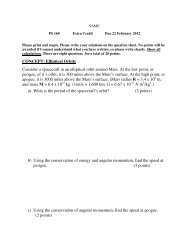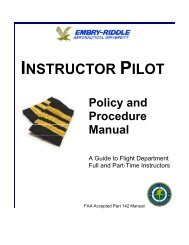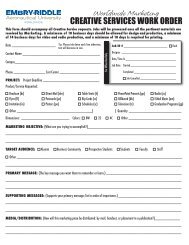checklist - ERAU ETA - Embry-Riddle Aeronautical University
checklist - ERAU ETA - Embry-Riddle Aeronautical University
checklist - ERAU ETA - Embry-Riddle Aeronautical University
You also want an ePaper? Increase the reach of your titles
YUMPU automatically turns print PDFs into web optimized ePapers that Google loves.
106 PA-28R-201 SOP<br />
WARNING<br />
Before trouble shooting the engine failure (partial or complete<br />
loss of power), establish the best glide airspeed, pick the best<br />
suitable landing site, and turn towards the landing site selected.<br />
1. AIRSPEED 79 KIAS<br />
Ensure that the airplane is trimmed for 79 KIAS (best glide airspeed, 2750<br />
lbs.) to provide the maximum gliding distance possible.<br />
NOTE<br />
While the published PA-28R-201 glide ratio (no wind, 2750 lbs.,<br />
propeller control full decrease, 79 KIAS) is approximately 2.0<br />
nm per 1000 feet of altitude, during training [propeller control<br />
full increase (high RPM)] the actual ratio will be lower.<br />
2. LANDING SITE SELECT<br />
SELECT the most suitable LANDING SITE and site of intended landing and<br />
turn towards that site. If surface conditions make selecting a site difficult to<br />
determine, turn toward the best area (flatlands versus mountains), and pick<br />
a site as it becomes visible.<br />
WINDS: To optimize landing performance, plan for a normal landing into<br />
the wind. Use the direction of travel of smoke or dust, the “glassy side” of a<br />
lake or pond, windmills or windsocks, and the surface wind report for the<br />
area to determine wind direction and velocity.<br />
NOTE<br />
Surface conditions, such as direction of furrows and available<br />
stopping distance, should be considered when selecting a<br />
landing site.<br />
Whenever possible, plan to execute a normal traffic pattern. When altitude<br />
permits, plan to spiral over your intended landing area to arrive at<br />
approximately 1000’ AGL on downwind, abeam the point of intended<br />
touchdown (high-key point). Plan on turning from the base leg (low-key<br />
point) to final at approximately 500’ AGL, adjusted as necessary for wind<br />
conditions.<br />
Revised 07-01-2012 © <strong>Embry</strong>-<strong>Riddle</strong> <strong>Aeronautical</strong> <strong>University</strong> Rev 06

















